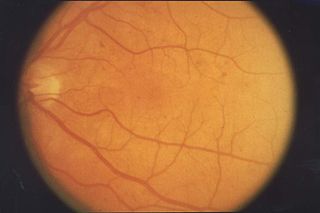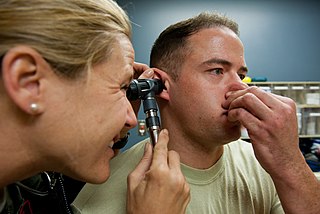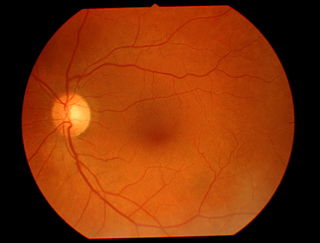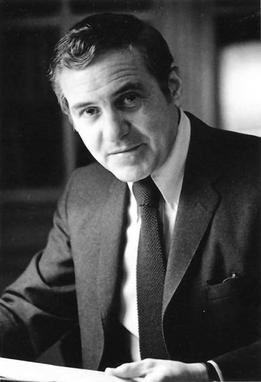Related Research Articles

Ophthalmology is a surgical subspecialty within medicine that deals with the diagnosis and treatment of eye disorders.

Retinopathy is any damage to the retina of the eyes, which may cause vision impairment. Retinopathy often refers to retinal vascular disease, or damage to the retina caused by abnormal blood flow. Age-related macular degeneration is technically included under the umbrella term retinopathy but is often discussed as a separate entity. Retinopathy, or retinal vascular disease, can be broadly categorized into proliferative and non-proliferative types. Frequently, retinopathy is an ocular manifestation of systemic disease as seen in diabetes or hypertension. Diabetes is the most common cause of retinopathy in the U.S. as of 2008. Diabetic retinopathy is the leading cause of blindness in working-aged people. It accounts for about 5% of blindness worldwide and is designated a priority eye disease by the World Health Organization.

The Valsalva maneuver is performed by a forceful attempt of exhalation against a closed airway, usually done by closing one's mouth and pinching one's nose shut while expelling air out as if blowing up a balloon. Variations of the maneuver can be used either in medical examination as a test of cardiac function and autonomic nervous control of the heart, or to clear the ears and sinuses when ambient pressure changes, as in scuba diving, hyperbaric oxygen therapy, or air travel.
Retinopathy of prematurity (ROP), also called retrolental fibroplasia (RLF) and Terry syndrome, is a disease of the eye affecting prematurely born babies generally having received neonatal intensive care, in which oxygen therapy is used due to the premature development of their lungs. It is thought to be caused by disorganized growth of retinal blood vessels which may result in scarring and retinal detachment. ROP can be mild and may resolve spontaneously, but it may lead to blindness in serious cases. Thus, all preterm babies are at risk for ROP, and very low birth-weight is an additional risk factor. Both oxygen toxicity and relative hypoxia can contribute to the development of ROP.

Fluorescein angiography (FA), fluorescent angiography (FAG), or fundus fluorescein angiography (FFA) is a technique for examining the circulation of the retina and choroid using a fluorescent dye and a specialized camera. Sodium fluorescein is added into the systemic circulation, the retina is illuminated with blue light at a wavelength of 490 nanometers, and an angiogram is obtained by photographing the fluorescent green light that is emitted by the dye. The fluorescein is administered intravenously in intravenous fluorescein angiography (IVFA) and orally in oral fluorescein angiography (OFA). The test is a dye tracing method.

The optic disc or optic nerve head is the point of exit for ganglion cell axons leaving the eye. Because there are no rods or cones overlying the optic disc, it corresponds to a small blind spot in each eye.
Norrie disease is a rare disease and genetic disorder that primarily affects the eyes and almost always leads to blindness. It is caused by mutations in the Norrin cystine knot growth factor (NDP) gene, which is located on the X chromosome. In addition to the congenital ocular symptoms, the majority of patients experience a progressive hearing loss starting mostly in their 2nd decade of life, and some may have learning difficulties among other additional characteristics.

Cotton wool spots are opaque fluffy white patches on the retina of the eye that are considered an abnormal finding during a funduscopic exam. Cotton wool spots are typically a sign of another disease state, most common of which is diabetic retinopathy. The irregularly shaped white patches are a result of ischemia, or reduced blood flow and oxygen, in the retinal nerve fiber layer, which is located in the distribution of the capillaries of the superficial layer of the retina. These areas with reduced blood flow reflect the obstruction of axoplasmic flow due to mechanical or vascular causes and the consequential accumulation as a result of decreased axonal transport. This reduced axonal transport can then cause swelling or bulging on the surface layer of the retina, increasing the potential for nerve fiber damage.

Laser coagulation or laser photocoagulation surgery is used to treat a number of eye diseases and has become widely used in recent decades. During the procedure, a laser is used to finely cauterize ocular blood vessels to attempt to bring about various therapeutic benefits.

Purtscher's retinopathy is a disease where part of the eye (retina) is damaged. Usually associated with severe head injuries, it may also occur with other types of trauma, such as long bone fractures, or with several non-traumatic systemic diseases. However, the exact cause of the disease is not well understood. There are no treatments specific for Purtscher's retinopathy, and the prognosis varies. The disease can threaten vision, sometimes causing temporary or permanent blindness.

Teleophthalmology is a branch of telemedicine that delivers eye care through digital medical equipment and telecommunications technology. Today, applications of teleophthalmology encompass access to eye specialists for patients in remote areas, ophthalmic disease screening, diagnosis and monitoring; as well as distant learning.
Julia A. Haller is an American ophthalmologist who is a Professor and Chair of the Department of Ophthalmology at Sidney Kimmel Medical College at Thomas Jefferson University. She also holds the William Tasman, M.D. Endowed Chair at Wills Eye Hospital in Philadelphia, where she is Ophthalmologist-in-Chief.

Peter Wiedemann is a German ophthalmologist, specialist in medical and surgical retina and was head at the Department of Ophthalmology at the Leipzig University, Germany, from 1993 to 2021.

Yog Raj Sharma is an Indian ophthalmologist and ex-chief of Dr. Rajendra Prasad Centre for Ophthalmic Sciences of the All India Institute of Medical Sciences (AIIMS), New Delhi, the apex body of the National Programme for the Control of Blindness, a Government of India initiative to reduce the prevalence of blindness in India. He is the Chairman of the Task Force on Prevention and Control of Diabetic Retinopathy Group and the Co-Chairman of the National Task Force on Prevention of Blindness from Retinopathy of Prematurity under the Ministry of Health and Family Welfare of the Government of India. An advisor to the Ministry of Health and Family Welfare, India. Sharma was honored by the Government of India in 2015 with Padma Shri, the fourth highest Indian civilian award. In 2005, Yog Raj Sharma's published article on "Pars plana vitrectomy vs scleral buckling in rhegmatogenous retinal detachment" in Acta Ophthalmologica Scandinavica and in November 2021, American society of retina specialists cited it as top 100 publications on retinal detachment management in the last ~121 years. Of these top hundred publications, only nineteen countries contributed, three of the contributing countries were Asian and from India this study was the sole contribution. Dr Sharma called it 'the singular biggest achievement of his career" in an article published in Daily Excelsior, Jammu in December 2021.

Leonard Apt was an American pediatrician and ophthalmologist. He was one of the first U.S. physicians to complete a fellowship in pediatric ophthalmology. Apt identified that povidone-iodine could be safety used as an antimicrobial for the eyes. In addition to his work in ophthalmology, Apt devised a number of diagnostic tests. The Apt test is performed on blood in a baby's stools to determine whether it is of maternal or fetal origin.

Emily Ying Chew, M.D., is an American ophthalmologist and an expert on the human retina with a strong clinical and research interest in diabetic eye disease and age-related eye diseases. She currently works for the National Eye Institute (NEI) at the National Institutes of Health (NIH) in Bethesda, Maryland, where she serves as deputy director of the Division of Epidemiology and Clinical Applications (DECA) and the Institute's deputy clinical director. She designs and implements Phase 1, 2 and 3 clinical trials at the NIH Clinical Center. Chew is board certified in ophthalmology.
Sanjay Sharma M.D., FRCSC, is a Canadian ophthalmologist, epidemiologist, and Professor of ophthalmology and epidemiology at Queen's University. He currently serves as head of the retina service at Hotel Dieu Hospital. Sharma is known for developing MEDSKL, a free open access medical education (FOAMed) initiative, for medical students that is promoted through the Canadian Federation of Medical Students (CFMS) and used by medical students in more than 50 universities. As a result, the Association of Faculties of Medicine of Canada (AFMC) granted him the John Reudy award for innovation in medical education in 2017. He also received the Ontario Medical Association achievement award 2012 - Innovation in the field of Ophthalmology, an American academy of ophthalmology achievement award (2004) and the Ron Michaels Foundation award (1998).
Dr. William Tasman (1929–2017) an American ophthalmologist, was the ophthalmologist-in-chief at Wills Eye Hospital His work had a profound impact on the treatment of retinopathy of prematurity (ROP). He served as the president of the American Academy of Ophthalmology, the president of the American Ophthalmological Society, the president of the Retina Society, the editor for Duane's Clinical Ophthalmology, and the editor for Survey of Ophthalmology,
Noemi Lois is a Clinical Professor of Ophthalmology at Queen's University Belfast and an Honorary Consultant Ophthalmologist and Vitreoretinal Surgeon at the Belfast Health and Social Care Trust.
Valsalva retinopathy is a form of retinopathy due to retinal bleeding secondary to rupture of retinal vessels caused by intrathoracic or intra-abdominal pressure due to physical activities. It can occur in any person irrespective of age, gender, race or health status.
References
- 1 2 3 4 "Obituary for Thomas D. Duane Duane (Aged 75)". The Daily Item. 25 June 1993. p. 13.
- 1 2 "Ophthalmology Oral History Series- Interview with Thomas David Duane" (PDF).
- 1 2 "DR. THOMAS D. DUANE, 75, EYE SCIENTIST, TEACHER". Sun Sentinel.
- 1 2 Lambert, Bruce (25 June 1993). "Thomas Duane, 75; Won Highest Honor For Ophthalmology". The New York Times.
- ↑ "Valsalva Retinopathy". eyewiki.aao.org.